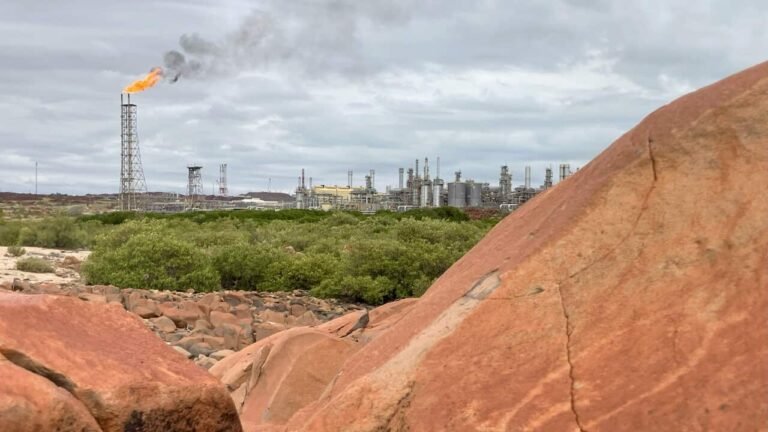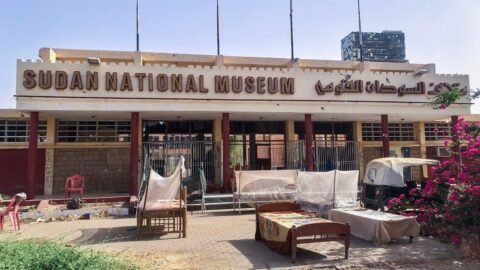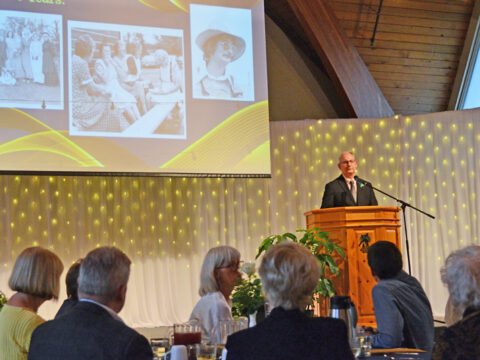More than a million pieces of ancient rock art have secured World Heritage status in a bittersweet listing for Traditional Custodians, scientists and environmentalists, who are fearful nearby industrial activity is damaging the engravings.
The Murujuga rock art landscape on the Burrup Peninsula in Western Australia was listed by the United Nations Educational, Scientific and Cultural Organisation (UNESCO) as a heritage site late last week after intense lobbying by the federal government.
Federal Environment Minister Murray Watt was accompanied to the UNESCO meeting in Paris by representatives from the Western Australian government and Murujuga Aboriginal Corporation (MAC).
Murujuga contains the world’s largest, densest and most diverse collection of petroglyphs, a type of rock art where the design is carved into the surface of the rock.
Some are estimated to be more than 50,000 years old.
They depict animals, plants and human figures and are visible due to the colour and contrast between the removed varnish layer and the underlying brighter weathered rind of the host rocks.
The site was put forward to UNESCO for World Heritage listing in 2023, but the application was referred back in May over concerns nearby acid emissions, including those from Woodside’s Burrup gas hub, were degrading the art.
The peninsula in northwest WA near Karratha is home to two gas plants, a fertiliser plant and iron ore and salt export facilities.
Senator Watt recently gave provisional approval for the Woodside North West Shelf project on the peninsula, which includes the Karratha gas plant, to continue operating until 2070.
Custodians celebrate listing, while concerns remain over pollution
Raelene Cooper, Murujuga custodian of the Mardudhunera people and founder of Save our Songlines, has been in Paris with other First Nations leaders pushing for Murujuga to be listed as a World Heritage site, but with the explicit intention of ensuring any listing comes with strict conditions to sufficiently manage industrial impacts on the site.
“My family and community have worked for many years for World Heritage protection for Murujuga’s ancient rock art,” she said.
“This is a momentous day for our old people and our future generations, to have Murujuga’s outstanding universal heritage values recognised by the world.
“Our rock art tells the stories of our people, and maintains our Songlines and bloodline connection to our ngurra (Country).”
Ms Cooper said while she was overjoyed about the World Heritage listing, she was deeply concerned about the pollution from surrounding heavy industry.
Part of the government’s lobbying efforts involved removing protections suggested by UNESCO’s independent advisory body ICOMOS in May from the final approval.
“Fertiliser plants are still being built around our sacred sites and polluting gas plants will emit toxic acid on our rock art for another 50 years,” she said.
“But comments from World Heritage Committee members today send a clear signal to the Australian Government and Woodside that things need to change to prevent the ongoing desecration of Murujuga by polluting industry.
“Global scrutiny will now be applied to what is happening at Murujuga. We will continue to fight for protection for this very special place, and the world is now aware of what we are up against.”
Murujuga Aboriginal Corporation, which represents the collective voice of the Ngarda-Ngarli (Traditional Owners and Custodians), said they were elated to see the Murujuga Cultural Landscape recognised.
“While today’s inscription is recognition of the hard work that MAC has put in … over the past two years, more importantly, it is recognition of the way our ancestors have managed this extraordinary landscape for over 50,000 years,” said MAC Chair Peter Hicks.
“World Heritage is the mechanism we will use to continue to do what we have always done: protect our culture for all future generations.”
But Ben Smith, Professor of Archaeology (World Rock Art), at the University of WA, said that unless pollution is drastically curbed, the rock art is at risk of serious degradation.
“While I celebrate Murujuga receiving the well deserved status of being listed as a World Heritage site, the nature in which the Australian Government handled the scientific findings on industrial impacts on Murujuga during this process reveals the extent to which they will go to play down the impacts of our gas industry,” he said.
“The scientific data clearly demonstrated the advanced weathering of the Murujuga petroglyphs from heightened levels of certain airborne pollutants from the nearby Woodside gas processing facility, yet we saw this repeatedly dismissed by different levels of government, with graphs and data being manipulated to back up the narrative that no conditions were required for the listing.
“One only hopes that Murujuga’s listing as a World Heritage Site spurs the government to no longer shirk their responsibility to conserve and protect this globally significant rock art site, and we see proper measures put in place to stop the polluting gas industry from degrading our First Nations cultural heritage.”
Foundation of culture
Ngarluma woman Samantha Walker wrote to the nominations unit at the UNESCO World Heritage Centre and the director of evaluation unit at ICOMOS, urging the WHC to list Murujuga as a world heritage site with specific recommendations to have independent bodies monitor and manage industrial pollution at Murujuga.
“Murujuga is more than just rock art – it is who we are,” she wrote.
“Murujuga contains Songlines and stories that define our identities as First Nations people, connecting us to our Elders and people that have walked before us.
“Murujuga is the foundation of our culture.
“The health of Murujuga is the health of my people and the ngurra (Country) is crying out for help.”
Ms Walker said Murujuga is sacred, but also has a dark history due to colonisation and the Flying Foam Massacre of 1868.
“That history of colonisation is being continued on by the way that government allows multi-billion-dollar industries to operate on Murujuga without having to obtain free, prior and informed consent or listen to the people whose Country this is,” she said.
Ms Walker also expressed her alarm at the Environment Minister’s provisional approval to extend the lifetime of Woodside Energy’s North West Shelf gas plant to 2070.
“It is unfathomable to imagine the French Government approving industrial pollution at the site of the 17,000 plus year-old Lascaux cave paintings.
“Why is there not more global outrage that Minister Watt and the Australian Government have given provisional approval for 40 more years of pollution that is damaging the 50,000 plus year-old Murujuga rock art on our Country?”
Environmentalists were also concerned the Woodside project extension could cause further damage.
“The world is now watching,” Australian Conservation Foundation chief executive Kelly O’Shanassy said.
“The onus is on the Australian government to make sure the values recognised by UNESCO are not jeopardised by ongoing industrial pollution.”
As part of the immediate inscription, the Australian Government will provide a state of conservation report for consideration in 2027.
Murujuga will become the second place in Australia recognised on the World Heritage List solely for its First Nations cultural heritage, following the listing of Budj Bim in 2019.
Senator Watt said it had been a great privilege to support the Traditional Owners and Custodians of Murujuga, who have protected the landscape for more than 50,000 years.
“The Australian Government is strongly committed to World Heritage and the protection of First Nations cultural heritage – and we will ensure this outstanding place is protected now and for future generations,” he said.
A Woodside spokesperson said the company had been a “proud supporter” of the World Heritage nomination and assessment process and they looked forward to continuing to work closely with MAC on the continued protection and management of this globally significant area.
UNESCO added several other sites to its list, including the Xixia Imperial Tombs in China and the Faya Palaeolandscape in the United Arab Emirates.





